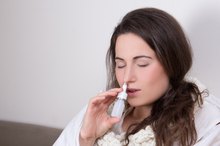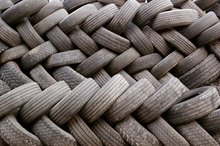The Effects of Inhaling Raid Ant & Roach Spray
The convenience of spray insecticides, such as Raid Ant & Roach Spray, allows the homeowner to quickly lay down a defensive barrier against the invasive little pests. While easy to apply, users should be aware of the dangers of inhaling or otherwise ingesting the chemicals in the spray. Accidentally inhaling the spray can cause irritation to the nose, throat and lungs. It can also affect the central nervous system in high doses.
Respiratory Effects
The National Library of Medicine's Toxicology Data Network reports that at the time of exposure, cypermethrin -- one of two active ingredients in Raid Ant & Roach Spray -- can cause shortness of breath, coughing and congestion. It can also cause an asthma attack and wheezing.
Inhaling cypermethrin may also cause a hypersensitive reaction that leads to pneumonitis and pulmonary edema.
Among the symptoms reported after inhalation of imiprothrin, the second active ingredient, are airway irritation, dizziness, headache and sneezing. There have been reports of respiratory paralysis and cardiac arrest, but these reactions are rare.
Skin Reactions
The Effects of Roach & Flea Raid Spray on Humans
Learn More
In addition to inhalation, overspray may get on the user's skin. While the spray can cause a skin reaction, quickly washing with soap and water removes the residue. If skin irritation develops, see the doctor.
Tips
First aid: If a user accidentally inhales the spray, move her to fresh air as quickly as possible. Call 911 if she has difficulty breathing.
- In addition to inhalation, overspray may get on the user's skin.
- While the spray can cause a skin reaction, quickly washing with soap and water removes the residue.
Wasp and Hornet Spray
Homeowners may also use wasp and hornet sprays to kill wasps building nests on or near the house. Raid Wasp & Hornet Killer 33 contains cypermethrin and prallethrin 3. It causes respiratory distress if inhaled, including coughing and wheezing, as well as dizziness, headache and burning or itching of the face.
- Homeowners may also use wasp and hornet sprays to kill wasps building nests on or near the house.
- It causes respiratory distress if inhaled, including coughing and wheezing, as well as dizziness, headache and burning or itching of the face.
Safe Practices
Harmful Effects of Xylene
Learn More
When using any spray pesticide, avoid inhaling the product. A long-sleeved shirt, long pants, shoes, gloves, a dust mask and safety goggles protect the skin, lungs and eyes from accidental exposure. Wash your hands with soap and water immediately after using the spray. Change your clothes and put the exposed clothing in the washer, and wash with hot water and laundry detergent.
Warnings
Keep children and pets out of the treated area. And keep the unused spray out of reach in the garage or in a locked cabinet.
Active Ingredients
Imiprothrin and cypermethrin, the active ingredients that make up 0.1 percent of Raid Ant & Roach Spray, are pyrethroids, which are synthetic insecticides. They are based on the naturally occurring pyrethrins found in Chrysanthemum cinerariifolium. Pyrethrins and pyrethroids are highly toxic to insects, honeybees and fish.
- Imiprothrin and cypermethrin, the active ingredients that make up 0.1 percent of Raid Ant & Roach Spray, are pyrethroids, which are synthetic insecticides.
- Change your clothes and put the exposed clothing in the washer, and wash with hot water and laundry detergent.
Related Articles
References
- SC Johnson: Material Safety Data Sheet: Raid Ant & Roach Killer 17 - Lemon Scent
- U.S. Department of Health & Human Services: Raid Ant & Roach Killer (Institutional)
- U.S. Department of Health & Human Services: Raid Wasp & Hornet Killer 33
- National Pesticide Information Center: Pyrethrins General Fact Sheet
Writer Bio
With degrees in fine and commercial art and Spanish, Ruth de Jauregui is an old-school graphic artist, book designer and published author. De Jauregui authored 50 Fabulous Tomatoes for Your Garden, available as an ebook. She enthusiastically pursues creative and community interests, including gardening, home improvement and social issues.









